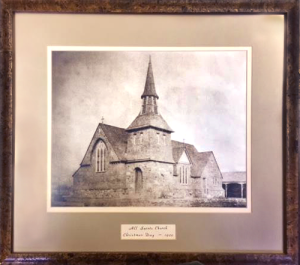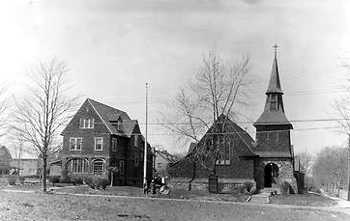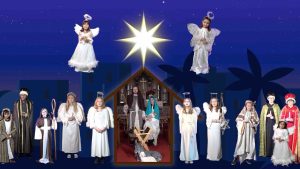All Saints Church traces its history back to the 1860’s. A Sunday School, organized by The Brotherhood of St. George, a missionary society of St. George’s Church in Flushing, began meeting in the local district school. In 1874, these services expanded to include lay services conducted by a seminarian, Mr. Van De Water. When Mr. Van De Water became the rector of St. Andrew’s Church in Harlem, the services in Bayside ended. Lay services resumed in 1891 under the direction of another seminarian, Mr. St. Clair Hester. He served until his ordination. Mr. St. Clair Hester was called to ministry outside the New York area. He was followed by Mr. George Bartow, who conducted services until after the church was built. Two women, Mrs. Mangles and Miss Frances Ahles, worked throughout this period so that Sunday School continued in Bayside.

In July 1891, Mrs. Frederick Lawrence donated four lots of land on Montauk Avenue (now 40th Avenue) for the construction of a church. Ground was broken in March of 1892. The Bishop of Long Island, the Right Reverend A. N. Littlejohn, granted canonical consent for the new church, named All Saints Episcopal Church, on October 3, 1893. The first service was held on October 9th. Mr. George Bartow became the first rector with a yearly salary of five hundred dollars. Critical support of the new All Saints church came from the Ladies Guild. The Guild, formed in 1891 before the church was constructed dedicated themselves to providing Christian Service to the area, increasing membership, and raising funds. The vestry asked them for donations on several occasions and even drew up terms for a loan of nearly three hundred dollars to help pay for construction of the rectory. They agreed to make the loan from funds they had gathered for construction of the original Parish House.
All Saints grew during the early decades. From 1911 to 1930, the Reverend Charles Brown was the rector. He served for nineteen years. During his tenure, All Saints came into its own as an important community of faith in Bayside. Mr. Brown was succeeded by Reverend Richard Trapnell. In 1940, after keeping the parish both vital and solvent during the Great Depression, Mr. Trapnell resigned to take a parish in Seaford, Delaware. His successor, The Reverend Howard R. Dunbar presided over a period of both numerical and physical growth for All Saints. Clearly, it was time to build a Parish House to accommodate the needs of the growing congregation. In 1941, Mr. William Johns, Senior Warden, donated the building site, and offered a challenge grant of ten thousand dollars for the parish to match. Many parishioners contributed to the effort, some funds were obtained through a mortgage and despite the restrictions and hardships presented by the Second World War, the parish house was built. Sunday school attendance soared during the tenure of Reverend Howard Dunbar so the new Parish House was put to good use.

In the 1950s and 60s All Saints continued to thrive in that golden period when it seemed nearly everyone in America attended church or synagogue. In 1962, under the Rev. Elmer Horstmann, All Saints began its last major building project, an addition to the front of the church. This addition provided room for several more pews, a spacious narthex, and a balcony. The late 1960s and the 1970s were, of course, times of a great deal of social change in our country, and in the Episcopal Church. With an increased awareness of ecumenism, came experiment and ultimately change in the Church. By 1973, a new prayer book was in the works, by 1976 it was provisionally adopted and made official by the 1979 General Convention. In that time, too, women were first ordained to the priesthood, and the Holy Eucharist became the primary worship service. The Rev. James Webster and the Rev. John Lawrence presided over these years of change and kept the parish strong. In 1982, The Rev. Alan Edmiston began his tenure of nearly twenty years. He was well loved as a pastor and preacher, and presided over the Centennial celebration of the parish in 1992.
Bayside is an ever-changing community. Like so many Episcopal parishes in the past ten or twenty years, our numbers are not what they were in the 1950’s and 60’s. However, the heart of the parish is strong and we are once again growing. All Saints has had many talented and dedicated clergy, and by the grace of God through the efforts of these spiritual leaders, and, perhaps more importantly through the dedication of her members, All Saints has grown into a loving community of faith. After a season of interim clergy, each of whom made unique contributions to the parish, our current rector, The Rev. Laurence G. Byrne is committed to ensuring that All Saints is a welcoming place for all to come explore and deepen their faith and to reach out to those in need in Bayside and beyond.

In March 2020, All Saints was forced to move all services online due to the COVID-19 Pandemic. With the support and expertise of Teddy Byrne, All Saints did not miss a week of services, despite being unable to have any parishioners in the church building. During the Summer of 2020, All Saints served as a testing site for live-streaming equipment in the Diocese of Long Island. Over the course of the summer, the church was equipped with cameras, microphones, lights, and other needs for spreading the word of God in the Twenty-First Century.
On All Saints Day 2020, a limited number of parishioners were able to gather in the space again for the first time since the onset of the Pandemic. In December, the traditional Church School Christmas Pageant was adapted to a film format, with individual families coming to record their parts separately, to be combined later and shown during the 5:30pm service on Christmas Eve.
As time passed, pandemic restrictions were eased and more parishioners were able to return to the comfort of the pews. However, the investment in technology has allowed All Saints to increase the reach of its mission and ministry to anyone with an internet connection.
We invite you to come help us write the next chapters of our history.